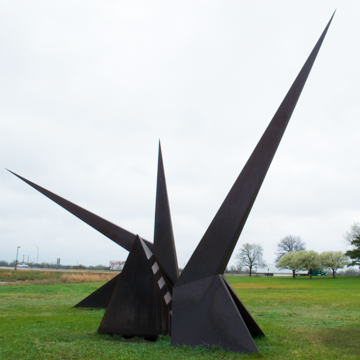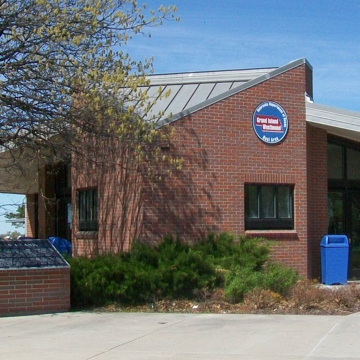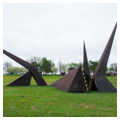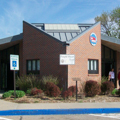The state government began planning I-80 in 1957, when Nebraska received federal funding authorized by President Eisenhower’s National Interstate and Defense Highways Act. Completed in 1974, the 455-mile interstate follows the Platte River Valley, transcontinental railroad, and many of the historic trails that once crossed the state including the Great Platte River Road, Trapper’s Trail, Oregon Trail, California Trail, Pony Express Route, and the Mormon Trail. There are twenty-five roadside rest areas along the route.
The Grand Island Rest Area is located eight miles southeast of downtown Grand Island, positioned near milepost 315 on the eastbound highway. Set on rural site of twenty-three-and-a-half acres, the rest stop consists of a modest red brick building with shallow gabled roof made of standing-seam metal. The structure contains restrooms and a tourist information station, and the site also includes parking for trucks and cars, seven picnic shelters, picnic tables, a children’s play zone, and a small fishing lake for interstate travelers.
The Grand Island Rest Area is notable for the environmental sculpture Erma’s Desire by John Raimondi. Positioned near the lake just west of the building, the sharp angular forms were made of steel, Raimondi explained, because it was a “critical material to this nation.” The artist intended Erma’s Desire to simultaneously evoke the restrictions of cages and the power of castles. Raimondi was one of ten American artists selected, following a two-round open competition, to create monumental sculptures at roadside rest areas along I-80 in honor of the U.S. bicentennial. Thomas A. Yates, a banking executive, devised the “455-mile sculpture garden.” Although the cities of Sidney, Ogallala, North Platte, Kearney, Grand Island, York, Seward/Milford, Lincoln, and Omaha were selected, due to political delays and funding issues only eight works were completed.
While contributing to the cultural life of Nebraska, the intent of the Bicentennial Sculpture Project was twofold. It sought to provide Nebraskans and visitors to the state access to high-quality sculpture outside of a museum. It also provided communities in the state the chance to meet the artists (through an artist-in-residence program), to understand the artistic process, and to learn about sculpture.
The Grand Island Rest Area, like I-80 itself, is a reminder of the impact of automobiles and infrastructure on Nebraska’s economic development and the state’s modest efforts to shape these sites to provide social and cultural amenities for its people.
References
Allen, Tom. “‘Erma's Sculptor Winning Over Critics.” Omaha World Herald, n.d.
Corbett, William. John Raimondi, Sculptor. New York: Hudson Hills Press, 1999.
Luebke, Frederick C. Nebraska: An Illustrated History. Lincoln: University of Nebraska Press, 2005.





















